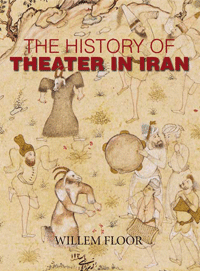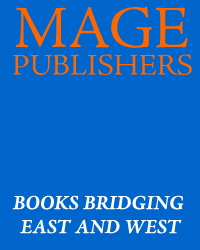
Opening a closed society
A forced Islamic identity creates a profound confusion to distinguish the real Iranian identity from the forged one
October 12, 2005
iranian.com
Identity is a series of collective characteristics by which a person should be recognised as a part of a given group. In my article, I raise up the question whether the Iranian identity is distinct.
The main reason of this identity crisis isthe process of political and social polarisations of the Iranians in recent decades rather than a material or immaterial substance of the past history.
Amongst many other characteristics which derive from different process of ethnical, geographical and historical developments, the one which is characterised by identity formation of the Islamic regime is more responsible for this identity-dilemma. The growing majority of Iranians, specifically among the youth, is motivated to demarcate their self identity from the one which is imposed by the regime. The social identity crisis comes to a head when the Iranian people in majority do not accept the identity imposed by a minority, but have to tolerate it as an acceptance of one's self.
The increasing trend of the educated Iranian middle class to immigrate to western countries shows that they want to avoid accepting a forced Islamic identity. Many of them hope one day they can go back to Iran to find again their own non-Islamic identity.
Nevertheless, it is time to raise alarm about the critical situation; an insular Islamic culture is on the march, it tramples down any concurrent and spearheads all over the country to spread or impose itself among different social categories. It propagates the claim that all nature of the Iranian entity is Islamic, since it follows this claim placed by God, therefore this Islamic identity should strive to surrender to God’s will in every aspect of the social life. In fact it is an identity formation which emerges when various early, elementary identifications and other influences are brutally rejected.
This aspect of the forced identity meanwhile creates a profound confusion to distinguish the real Iranian identity from the forged one.
A second fragment of Iranian subidentity is an alternative identity that relies on the nostalgia for the pre-Islamic past and the result of frustration from the Islamic identity presently imposed. Ancient Persia’s identity has symbolically been assimilated with the epoch of the last royal dynasty in Iran. This identity has neither root in the reality of our daily life nor can live up also to an identity based on today’s global values. It is a metaphor of a society divided into affluence for a minority and disgrace for the populace, a society deep in disparity, in which a little privileged group represents the only glorious identity in the name of a nation. Such an identity cannot be practically served to promote a common sense of need for modernity, democracy and social justice. Therefore it is like the Islamic identity hollow.
 An extreme side of this identity does not make attempts to avoid categorising the Iranian ethnic groups on the basis of racial priority, namely the Arabs, Turks and other Iranian ethnic groups are implicitly segregated as non-Aryan. The prejudice towards the Turks, Arabs and even their donkeys, camels and lizards is nothing but a banalised ethnic and racial discrimination. An extreme side of this identity does not make attempts to avoid categorising the Iranian ethnic groups on the basis of racial priority, namely the Arabs, Turks and other Iranian ethnic groups are implicitly segregated as non-Aryan. The prejudice towards the Turks, Arabs and even their donkeys, camels and lizards is nothing but a banalised ethnic and racial discrimination.
This second irrational identity as an abusive tool of the Pahlavi’s legacy has never served for the sake of people, but merely has been a propaganda tool used to impose the Pahlavi’s despotism on the Iranian society.
The unrealised process of modernisation under Reza Shah (1921-1941) and then his son Muhammad Reza Shah (1941-1979) failed to bring Iran from an undeveloped level, to a level of developing countries like its neighbour Turkey. The reason that this disturbs the Iranian identity under the Pahalavi and the IRI is in a general aspect due to the total lack of democracy, which is the primordial condition of being identical with oneself. All the measures, which are used to foster these dictators’ reins, at the same time damage or disturb the process of democracy that a nation needs to, define its distinct identity.
It is of course, for a nation, a cultural privilege to be enriched by multi-identities, those people who have lived in multicultural countries for generations, brought over their culture from somewhere else and this new culture was not imposed or suppressed, but coexists with other cultures. As long as the social pluralism is respected the multiculturalism can lead to an interesting exchange of many variations to enrich literature, art, music, foods, and intellectual aspects of philosophy and sociology. Iran as a multi-ethnic society can benefit from the subcultures of its rich civilisation.
But the goal of the Islamic regime is to establish an Islamic monoculture in Iran, which is characterised by the Islamic uniformity and is closed to all other cultural influences. The regime tries to sustain the concept of national identity for a community of believers, namely Ummah. Furthermore the regime has neither concern about the preservation and independence of the Iranian entity in all of its aspects and values nor the wellbeing of the Iranian people as a nation, but not as an Ummah.
Iranian classical literature, specifically poetry, plays an important and controversial role in the formation of the Iranian identity. A verse of poetry stands for a maxim or a pattern of noble character. The first aspect of Iranian famous poets such as Ferdowsi, Sadi, Hafiz, fosters Iranian identity by establishing Persian as a common language of all Iranians. The Ferdowsi’s Shah-Nameh rehabilitated the Persian language through an epic mytho-poeticisation and became a vehicle of the Iranian identity after three centuries of islamo-arabisation.
However the second disastrous aspect of these Iranian classical poets was a contribution of their lyric, mystical thought to the Iranian literature which would serve to a submissive popular culture favouring the dominance of the ruling class or the religion; a doomed determinism inspired by many of the post-Islamic and classical poets promoted passivity and submissiveness in the Iranian culture. The colloquial sense of this culture assimilates with the concept of Islamic determinism which requires complete submission to the will of Allah. The contribution of classical literature to the Iranian culture must be kept in respect as the collective artefact of the people, but not as the patterns of their personality traits.
In contrast to some Arabic countries, Islamic culture is not the main composant of the Iranian identity.
 Despite two centuries of Islamic Caliphate of Umayyad and Abbasid in Iran and then even with the help of palliative Schism as mediator between rejection and acceptance of Islam, Iranian identity has remained more persistant than the historically imposed Islamic identity. Despite two centuries of Islamic Caliphate of Umayyad and Abbasid in Iran and then even with the help of palliative Schism as mediator between rejection and acceptance of Islam, Iranian identity has remained more persistant than the historically imposed Islamic identity.
Iranism and Islamism are two concepts which have not been coupled with each other in a voluntary historical process. For that, like in the past, the Iranian cultural values have not been recognised by the IRI representing the Islamism in Iran and equally the Islamic cultural values are not voluntarily accepted by the majority of the Iranians, even Muslims.
Therefore the IRI seeks to forge a national presentiment meaning a community of believers or Ummah, a collective entity with less Iranian identity, which is far from a good patch on Iranism. As history shows, the Iranian nationalism itself emerged at the same time as the humiliating islamisation and arabisation of ancient Iran were imposed by the Islamic invaders. It is far from Iranian common sense that Islam represents a national identity. The recent history shows with no wonder that even a little dose of Mossadegh’s Iranian nationalism was not admired by Kashani’s clerical clique or the later generation of the Mullahs.
The Islamic regime, because of its conflict with the Iranian identity, stresses on the image of Islam as a legitimate Iranian identity, an image that inevitably falls back only on its own general goals and has no reliance on the Iranian collective acceptance. This Islamic identity has no dynamism to adjust itself with the primary needs of society; it is described by an odd, alien vocabulary. It is deep undercutting of obscure traditional habits and customs that radically alters the general nature of today’s life. It denies the most individual aspects of human activity. It defines itself as the only existing one, indivisible, and does not recognise the existence of other identities within Iran. It denies the emergence of all mechanisms reaching modern identities and disturbs the normal interconnection between people of different sex by dividing them into “Mahram and Non-Mahram”.
To shed light on the collective memory of the past several Iranian generations it is not easy to reconstruct a distinct picture of their identity. The collective elements creating a set of distinct behavioural characteristics for a nation have permanently been disturbed. The unconditional respect of individuality has been brutally rejected, labelling it a sinful act of secularism. All of this means that the impression of being the same does not exist within the society; see the tastes, reactions and judgements of Iranians in diverse subjects like music, clothes, art, literature, traditions and etc.
 The Iranians on a large scale are taken into a ramification of subidentities. This is, in great part, because they are unwillingly affected by the recent political and social polarisations which separate them suddenly from their normal course of social life and historical continuity. Their social life is radically oriented by the extreme political events of the past. By extension, the rationally accepted principles of today’s life are directly challenged and found wanting. The Iranians on a large scale are taken into a ramification of subidentities. This is, in great part, because they are unwillingly affected by the recent political and social polarisations which separate them suddenly from their normal course of social life and historical continuity. Their social life is radically oriented by the extreme political events of the past. By extension, the rationally accepted principles of today’s life are directly challenged and found wanting.
In the logic of social evolution, the self is not a passive entity, but rather a dynamic one which gains momentum to control or create necessary functions of personification. Therefore self is not only a logical construct of experiences, but also open to self-actualising, specifically in a world in which globalisation, with all its positive or negative aspects, accelerates the uninterrupted vehicle of information all over the world. Therefore a third alternative and flourishing identity among the young Iranian generation is trying to grow roots in other cultures. This trend is encouraged by the necessity of the interactions between cultures, a trend of sharing universal values, aims, and patterns of diverse cultures.
The generations of the post-revolution have the courage to ignore all the common labels created by their conservative parents or religious customs. They search to enrich their diverse selves. Therefore the Iranians in Iran are less concerned with losing their religious identity or failing to pass it on their next generation. This growing identity is an Iranian new melting pot where all the cultural ingredients are mixed and amalgamated without the Islamic regime’s intervention.
The growing identity should intelligibly answer to a national question of identity. There should be room to ask oneself some form of following questions: if Spain could free themselves from all aspects of Arab subidentity after 8 centuries of occupation, why should Iranians not be able to do the same.
 A great number of young Iranians in Iran, despite all restrictions, thanks to the Internet, satellite and other possibilities, develop their self-identity and evolve intact and non-stereotyped elements of the Iranian culture in accordance with a world of diversity and with a more satisfying understanding of the dynamism of their self. The Iranian immigrant communities and their second generation growing up in two complementary cultures, having the advantage of tow sides and the pride and consciousness of their Iranian descent, can interact by giving their young compatriots input to redefine a new Iranian identity. A great number of young Iranians in Iran, despite all restrictions, thanks to the Internet, satellite and other possibilities, develop their self-identity and evolve intact and non-stereotyped elements of the Iranian culture in accordance with a world of diversity and with a more satisfying understanding of the dynamism of their self. The Iranian immigrant communities and their second generation growing up in two complementary cultures, having the advantage of tow sides and the pride and consciousness of their Iranian descent, can interact by giving their young compatriots input to redefine a new Iranian identity.
It is not an insult to the great Iranian civilisation to accept new patters of development. No culture falls completely into another, but assimilates to encourage more universal enrichment. Maybe a cultural model of the Iranian second immigrant generation is not a bad pattern for the young generation in Iran to solve their identity dilemma. Perhaps we must accept the fact that under the barbaric Islamic regime there is, at least, one advantage and that is that we can set up all subjective conditions to remove some traditional norms to such a standard that the rest of the culture helps people in their way to achieve democracy, modernity and secularism. This third alternative is a necessary step towards solving the Iranian identity dilemma that currently plagues the youth of Iran.
|